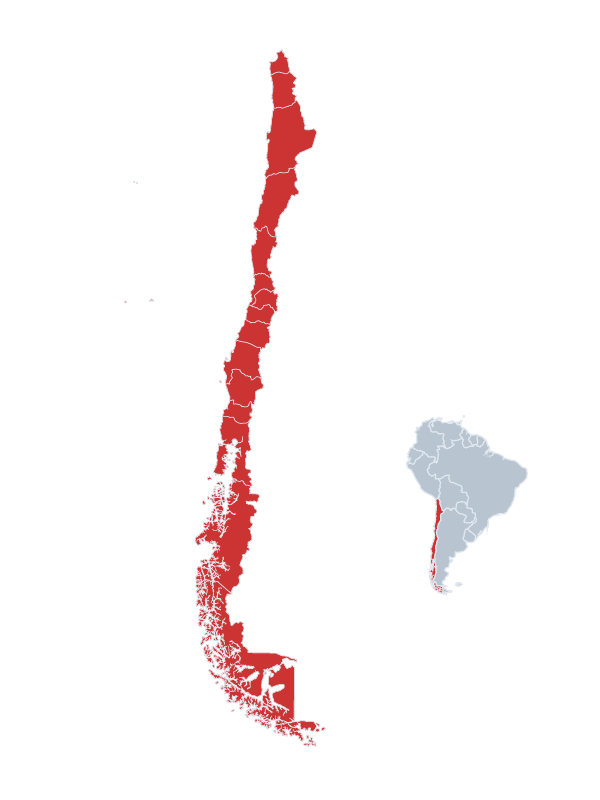Central Valleys: Santiago, Valparaíso
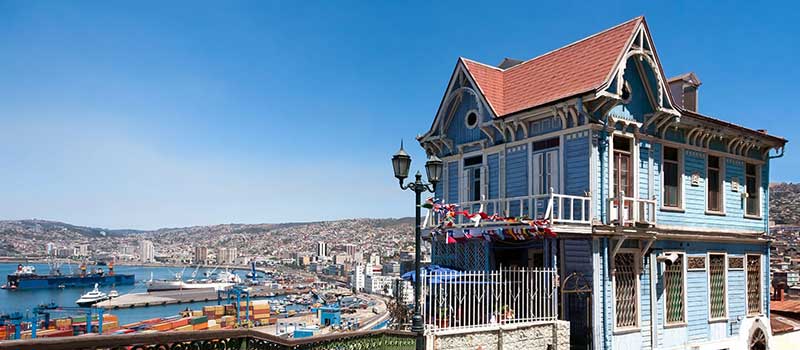
Lively, surprising, cosmopolitan, energetic, sophisticated and worldly, Santiago is a city of syncopated cultural currents, madhouse parties, expansive museums and top-flight restaurants.
It's a wonderful place for strolling, and each neighborhood has its unique flavor and tone. With a growing economy, renovated arts scene and plenty of eccentricity to spare, Santiago is an old-guard city on the cusp of a modern-day renaissance.
Valparaiso is a colorful, charming and painteresque city on the hills with the biggest port of Chile and UNESCO World Heritage Site. Valparaiso remains something of a secret – a tangle of gaudily-colored tumbledown houses draped across steep hills offering stunning viewpoints over a wide Pacific bay. Characterful vintage funicular lifts get people up and down. As well as surface beauty, the city enjoys a reputation as a bohemian idyll, with small cafes, quirky art shops and hidden bars.
At 675km west from Valparaiso, in the Pacific ocean, the Robinson Crusoe island is the star of the Juan Fernandez archipelago, an otherwise uninhabited group of volcanic islands. A scenically-diverse biosphere reserve with fantastic diving areas. It is possible to hike mountains draped with lush forests, and recharge in fishing hamlets majoring in lobster. There's brilliant diving too – plus a fascinating traditional cult of 'The Birdman'.
The charms of Chile's fertile heartland extend far beyond its famous gaucho cowboys. In the Central Valleys it is possible to relax on wine routes through areas like Colchagua or to adventure on a ski journey.
What can we do there?
-
SANTIAGO CITY TOUR
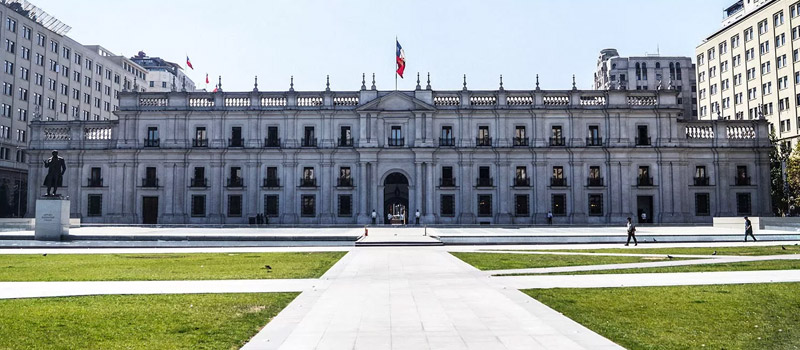
Duration: Half Day
Visiting points of interest: Lib. Bernardo O’Higgins Avenue, also known as Alameda, the backbone of the city up to Plaza Italia where it turns into Providencia Avenue. Santa Lucia hill, site of the foundation of Santiago in 1541, colonial and historical areas, Moneda Presidential Palace, Santiago City Council (1785-1790), Metropolitan Cathedral (1748), Forestal Park, National Museum of Fine Arts (1880) is located, San Cristobal Hill for a panoramic view of the city. Tour of the new sector of “Sanhattan” (popular name), located at the convergence of the communes of Las Condes, Providencia and Vitacura, east of the city. The area has more than 50 standard premium office towers. Since the early 1990s has become the main financial center displacing the downtown area, surrounded by major hotels, designer boutiques, gourmet restaurants and open-air cafes.
-
Culinary Santiago
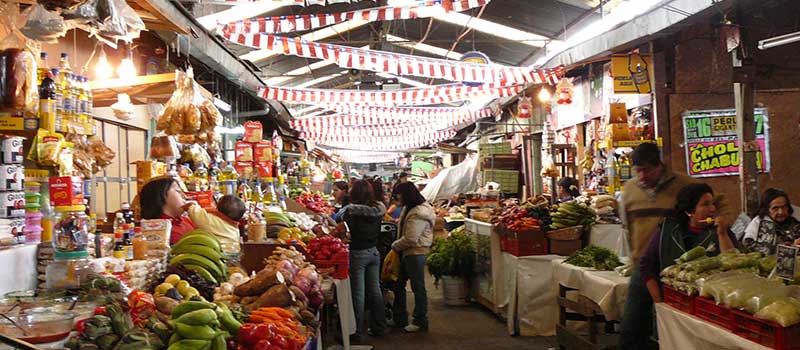
Duration: Half Day
Depart from your Santiago hotel and start with La Vega Market, to view our fresh fruits and vegetables, mainly from the Central Valley. After a stroll among the many colorful shops, leave the market on foot across the Mapocho River to visit another of Santiago’s famous markets, the Mercado Central (1872), with its beautiful colonial cast-iron roof. This is Santiago’s most important fish and seafood market where you will have a chance to see the bounty of the Chilean Pacific seas. Of course, the experience will not be complete until you sample a Chilean ceviche paired with a chilled Sauvignon Blanc from the Casablanca Valley, famous for its white wines. At present, the Central Market of Santiago is a renowned place for its gastronomy, which has managed to preserve ancient native recipes such as the paila marina (mix of local seafood, fish, white wine and spices served hot) and crisp fried fish, both part of the Chilean culinary heritage. Detouring a bit from the market scene, walk through the downtown colonial area and the Plaza de Armas, (main square), towards the government civic center to enter La Moneda Presidential Palace. After this walk and whirlwind history lesson, you are now ready for the next stop at the busy Providencia District, with its many commercial arcades and malls, exclusive boutiques, ample pedestrian walkways, restaurants and open-air cafés. Here you will try one of Chile’s most tasty snacks the empanada (a wheat flour dough, mainly filled with ground meat and onion, sliced hard-boiled eggs, olives and raisins), and of course, no empanada snack will be complete without a glass of excellent red wine from the Maipo Valley. Now it is time for the most important course in the Chilean meal, dessert. Chileans are dessert experts and the wide variety of cakes and tarts makes it impossible to experience them all. Coffee is our last stop at the Emporio La Rosa Café in the upscale district of Las Condes.
-
A Trip Into Santiago`s History Between the Years 1973-1989
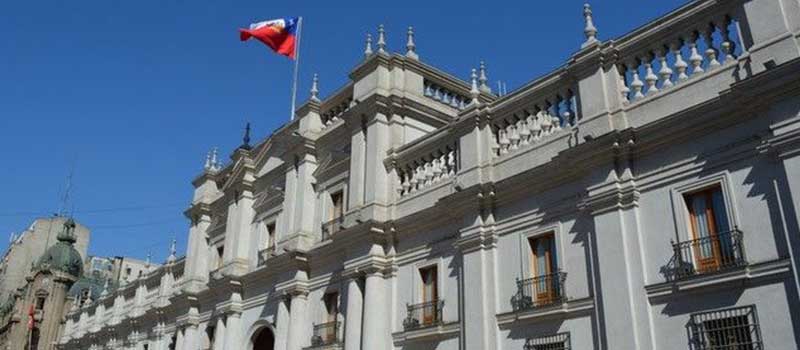
Duration: Full Day
Tour the city to learn about part of the history of Chile, which makes direct reference to the Military Coup of September 11, 1973 and the subsequent 17 years under the military regime led by General Augusto Pinochet. The tour begins with a visit to the Pinochet Foundation, touring its four rooms: Pillars of Freedom, Historic Corner of a Statesman, Architect of Freedom and Modernity and finally, Bravery and Patriotism. Proceed for a visit to the Libertador Bernardo O'Higgins Military Academy, for an insight view to the military and professional growth that General Pinochet had, his history as a teacher and expert in logistics, as well as his influence in the opening of the Ecuador Military Academy. The route continues towards the downtown area to visit the La Moneda Presidential Palace, walking its perimeter to explain the events that led to the military uprising of 1973. Continue with a relaxing walk to the Mercado Central, (1872), Santiago’s most important fish and seafood market to enjoy a delicious lunch menu, part of the Chilean culinary heritage.
In the afternoon, visit to the Yucatán Barracks, expropriated in 1973 to socialist José Gutiérrez by the DINA (National Intelligence), known colloquially as "the house of the bells", due to its proximity to the San Francisco Church. Prior coordination, a visit to the National Stadium is possible, to tour its facilities and the dependencies that acted as detention center of opponents to the military regime between September 12 and November 9, 1973. In this compound, more than forty thousand detainees passed; in one day, the Red Cross estimated seven thousand prisoners, of which about 300 were foreigners. Continue to Villa Grimaldi, detainee center for political prisoners, among others. In this place, visit the Wall of Names, located at the end of the park, featuring a monument in tribute to the many people detained, disappeared, or executed, as consequence of the torture held at Villa Grimaldi, between the years 1973 and 1978. In here are engraved the names of the victims who were killed, or which disappeared during these difficult years. * Note: In case, it is impossible to confirm the visit to the National Stadium, (subject to availability by events, concerts, or sports activities); a visit to the Memory and the Human Rights Museum can be coordinated as replacement. This museum is a space intended to give visibility to the violations of the human rights committed by the State of Chile between 1973 and 1990, to dignify the victims and their families and to stimulate reflection and debate about the importance of respect and tolerance, so that these events never recur.
-
Viña del Mar & Valparaiso
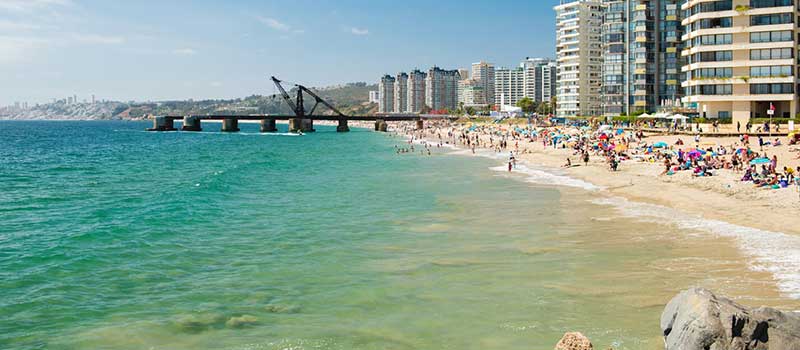
Duration: Full Day
Located only 120 km from Santiago in a beautiful rocky coast, VIÑA DEL MAR, also known as the “garden city”, is an important Southamerican summer resort, also home to the famous international song festival held every year in February.
VALPARAISO, the most important port in Chile, declared a World Heritage by UNESCO, built on hills in the coast of a busy bay. The true attraction of Valparaiso are the hills that divide the city in two levels with its characteristic and colorful buildings hanging from the hills and cliffs in an impressive layout of streets, side streets and alleys. The use of elevators to join the two levels of the city is a tradition.
-
Cousiño Macul Vineyard
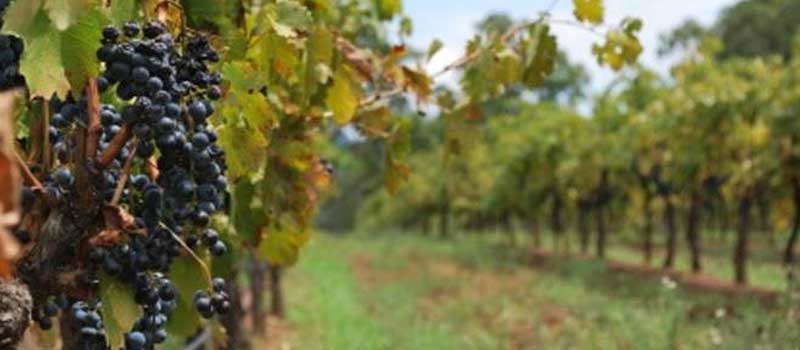
Duration: Full Day
Established in the 19th century is the only winery in Chile amongst those that continue 100% under the control of the founding family. The Basic tour (45min) includes a tour through the centenary cellars ending at the winery shop. Wine tasting included. The Premium tour (1h30min), including the history of the vineyard, visit of the centennial cellars, museum and the current cellars where life is given to Lota their icon wine. The tour will finish with a wine tasting of two reserved strains.
-
Santa Rita Vineyard
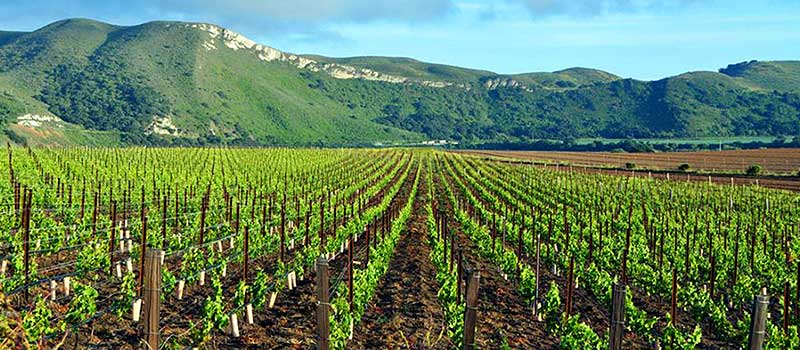
Duration: Half Day
Founded in 1880, by Domingo Fernández Concha, who introduced French strains giving birth to world famous wines. The winery, declared a National Monument, combines working the traditional barrels of French and American oak with modern production techniques that give its wines a unique aroma and body. The house, surrounded by a beautiful park, also declared National Monument, complements this traditional vineyard landscape. * Open: Tue. To Fri. - Private Service - Includes wine tasting.
-
The Casablanca Wine Route
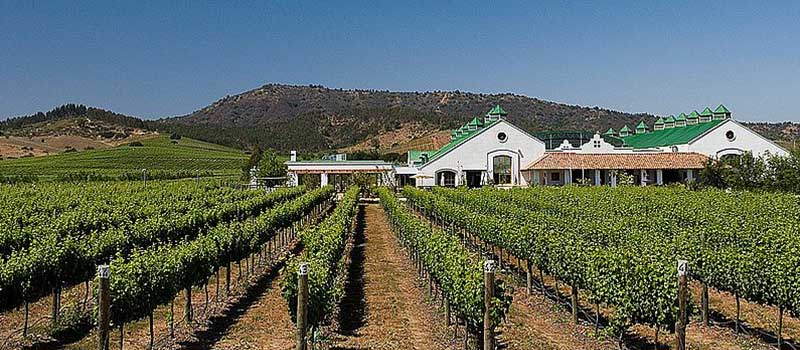
Duration: Full Day
In the morning departure driving along the picturesque Chilean countryside to one of Chile’s most important wine producing areas, the Casablanca Valley. Its privileged location, between the Andes and Coastal Mountain Ranges, create the perfect terroir for some of Southamerica’s finest wines. The tour includes the visit to three vineyards: Bodegas Re, a boutique vineyard with a unique concept based on Re-creating, Re-inventing and Re-vealing ancestral wines produced by this long wine- tradition family, using noble clay wine barrels so that the chemical process gives naturally. Casas del Bosque, with its 235 hectares of vines dedicated exclusively to the production of cold climate varieties: Sauvignon Blanc, Chardonnay, Riesling, Pinot Noir and Syrah. Viña Indómita, where the spirit of the vineyard lives in every corner of his imposing mansion with a panoramic view over the Valley and an elegant room with a capacity for 2500 oak barrels where the best Cabernet Sauvignon-Carmenère, Chardonnay, Pinot Noir, Merlot, Sauvignon Blanc, sparkling wines, late harvest, organic and varietals produce.
Note: Depending on schedule, lunch options at the Tanino restaurant at Viña Casas del Bosque, supervised by Chef Alvaro Larraguibel and oenologist Alvaro Larraguibel, who have worked jointly to achieve the perfect pairing between gastronomy and wines, or in the restaurant at Viña Indómita, under the gastronomic advice of the recognized Chilean chef Tomás Olivera.
-
The Wines of the Maipo Valley
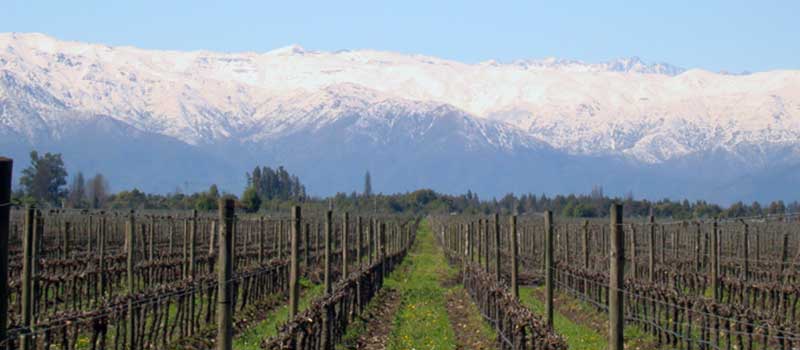
Duration: Full Day
The Maipo Valley is located between the Andes and the Coastal mountain range. More than 650 meters above sea level, the Alto Maipo sector rises over the pre-cordillera, strongly influenced by mountain climate promoting wines rich in color and tannins. They say the origin of the best Cabernet Sauvignon is in this valley. This excursion includes visits to three vineyards: Cousiño Macul, produced only with grapes of the properties located in the Maipo Valley: Macul, to the East of Santiago, and the new land to the South East of the Maipo Valley, near the city of Buin. The wines are produced, vinified and bottled in origin and are produced starting from 9 varieties: Cabernet Sauvignon, Merlot, Syrah, Cabernet Franc, Petit Verdot, Chardonnay, Sauvignon Grey, Sauvignon Blanc, Riesling. More than 60% of its production is red wines. Viña Aquitania, the first plantations were with strains from Bordeaux France, present in Chile since the end of the 19th century. The Cabernet Sauvignon grapes originate Rosé wines, fresh and slightly sweet in taste. Cabernet Sauvignon, fruit intensity and soft tannins. Lazuli (in homage to the gemstone of Chile), is the jewel in the production of Viña Aquitania, a pure Cabernet Sauvignon obtained from a careful combination of grapes and bordelaise. The weather conditions, the late harvest (at the end of April), the vinification and the ageing in French oak barrels give their Chardonnay an excellent balance. Santa Carolina is part of the Carolina Wine Brands, one of the main wine groups in Chile and one of the oldest vineyards in this area. The main strains grown are Cabernet Sauvignon and Syrah. The grapes harvested here develop brands such as Gran Reserva Cabernet Sauvignon, Reserva de Familia Cabernet Sauvignon and the Specialties Coastal Hills Syrah. Strains: Cabernet Sauvignon, Cabernet Franc, Malbec, Carmenère, Petit Verdot, Petit Syrah, Carignan.
Notes
- All visits include wine tasting.
- Additionally, Viña Cousiño Macul has guided cycling tours to explore the vineyards and try grapes from vines more than 80 years old. Visit the Cousiño family estate house, the historical cellars to appreciate the elaboration process of the wine and the equipment used between 1920 and 1990. Finally, the tour will reach the main winery, built underground in 1874 by French architects.
-
Ski Journeys
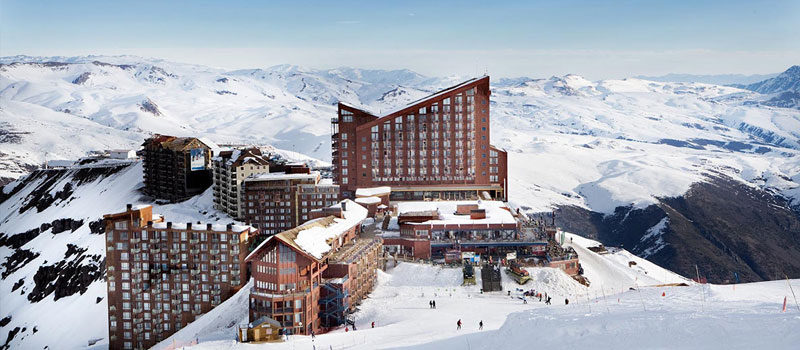
EL COLORADO is located on the Cerro Colorado at a maximum height of 3.333 m and a vertical drop of 903 m. It has 19 ski lifts: 2 double chairlifts, 3 triple chairlifts, and 12 draglifts allowing access to 101 ski tracks. It also houses an International Ski School. The area has small hotels and apartments for lease, restaurant, pub, bar, ski rental shop and individual ski lessons for children.
LA PARVA, at 2,650 m above sea level, overlooking the city of Santiago (50 km), very close to the El Colorado-Farellones resorts, has 14 lifts, chair and drag type, covering an area of 9,673 meters with slopes ranging between 2.5 and 412 meters, it is the only center facing north, which ensures sunshine on the tracks. 30 km of skiing area distributed in 30 tracks whose degree of difficulty varies between easy and difficult. As in other centers, the practice of heli-skiing and snowboarding are available for those who enjoy these modalities. It also houses a Ski and Snowboard School. The offer for accommodations is large, with more than 7,000 beds in lodges and private condominiums.
PORTILLO SKI RESORT Is located 149 km from Santiago at 2,850 m overlooking the Laguna del Inca, travelling along the International Highway, which also leads to the city of Mendoza in Argentina, through the magnificent beauty of the Andes mountain range. Portillo is the oldest ski resort in Southamerica, whose career is important part of the history of skiing in Chile. Portillo hosted the World Ski Championships in 1966. The ski domain is 500 hectares, 14 lifts and 35 tracks for advanced and professional skiers. The Centre also boasts a series of outside circuits, ideal for those who practice snowboarding. Between July and September of each season, depending on snow and weather conditions, you can enjoy the practice of heli-skiing accessing the slopes on a Euro copter AS350 B3 helicopter. The hotel has 123 rooms, all with a superb views to the Lagoon or to the Valley. Most of the activities, facilities and services perform at the same hotel, immersed in the mountain range. In addition, the Octagon and Inca Lodges, located just steps away from the hotel, are an excellent, more economical choice, especially for families or groups of friends. Also Chalets A1 and B2, for 7 to 8 people and Chalet C1 and C4 for four people with two bedrooms and two bathrooms.


